Satellite images are a powerful tool for Earth observation and monitoring sensitive areas. As part of the Copernicus program and mandated by the European Commission, ESA (European Space Agency) has implemented the Sentinel satellites, the guards of the planet. Thanks to this program, we could detect hydrocarbon pollution at large of the Brazilian coasts and provide evidence for local authorities to help uncover the origin of this major disaster.
At MURMURATION, we confirm the catastrophic situation that these Brazilian coasts are currently experiencing. As shown in the following Sentinel images, we are able to detect oil pollution off the Brazilian coasts in the east, in the state of Bahia.
Oil slicks are observed spanning over 20km, which corresponds to 800 Tennis courts!
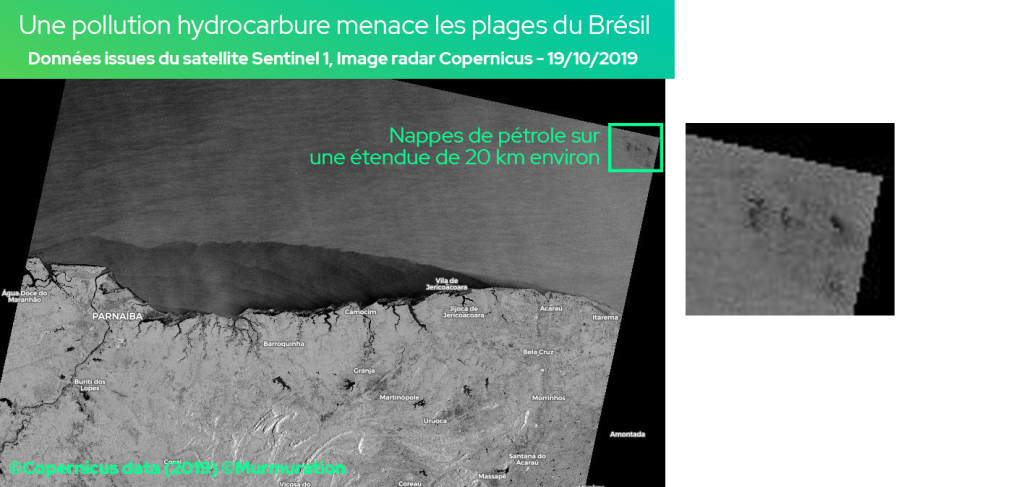
The Sentinel 1 radar images of the Copernicus program provide all-weather imagery (passing through cloud cover) thus enabling the handling of emergency situations (natural or industrial disasters) and environmental monitoring (sea ice, glaciers, water extents, landslide, and so on).
An extent of about 10 km of oil slicks was observed off Açu de Torre … which corresponds to nearly 400 tennis courts!
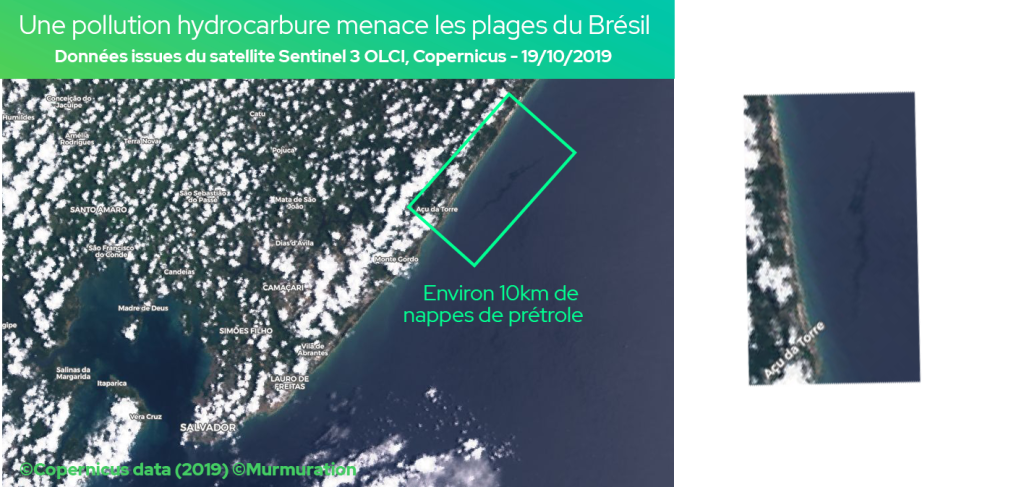
Sentinel 3 OLCI satellite images (Ocean and Land Color Instrument) allow measuring the state of the oceans and coastal zones (pollution, current …) thanks to color levels (spectral bands).
The Brazilian oil spill is an unprecedented ecological disaster with a short, medium and long-term impacts on the natural ecosystems and the economy of the country. Marine ecosystems are becoming stagnant while the country’s economy can be affected. Brazilian beaches, reputed for their beauty and attracting tourists from all over the world, may be deserted by travelers. The tourism sector is already heavily impacted by the situation ! But the worst is yet to come : Cleaning is almost impossible under current conditions.
O óleo no Nordeste e a destruição da Amazônia mostram as consequências do desmonte ambiental promovido pelo governo, prejudicando a imagem do país. Os impactos são gravíssimos para os oceanos, a Amazônia e a vida das pessoas. https://t.co/1PR9Rh6a1B #InimigoDoMeioAmbiente pic.twitter.com/sfZd2MxEla
— Greenpeace Brasil (@GreenpeaceBR) October 23, 2019
While the Global Climate Strike has begun these days around the world, we are looking at MURMURATION SAS for the growing impact of two crucial and social issues in terms of overtourism – which can be found through the case study from BALI.
Overtourism has become a crucial issue for the tourism sector. Moreover,, the effects of climate change have major issues, caused by humans and that directly affect our daily lives and the future.
We propose to counter the challenge of overtourism through the use of satellite data. Take the example of Indonesia: How a study on environmental impact could help to change the tourism sector in Bali
Bali is an Indonesian island famous for its wooded volcanic mountains, rice paddies, beaches and coral reefs. Unfortunately, it suffers from overtourism especially south of the island. Buildings are accelerating at the expense of nature and local life. and the lively tourist coasts do not benefit as much as locals in terms of economic development. the lively tourist coasts do not benefit as much as the locals in terms of economic development.

The map above gives some pointers to favor sustainable tourism, a true vector of love and peace between cultures.
The small town of Munduk offers to explore the inner region of Bali. The inhabitants of Munduk are less accustomed to crossing tourists but he remains very enthusiastic to meet and exchange with foreigners. The nature around Munduk allows beautiful breakaways. Many hiking trails start from Munduk and the surrounding hills soon become accessible. There are great walks in the forest with beautiful waterfalls and breathtaking views of rice terraces to the west of the city. Small Indonesian restaurants called “warung”, very simple and cheap, allow Indonesians and tourists to enjoy the local gastronomy. The traveler becomes an active player in his journey by choosing to go where his presence will be a source of meetings and sharing. The map above would avoid the mistakes made in the past and propose a sustainable tourism management taking into account the water needs, the establishment of the infrastructures necessary for the accommodation, and also the management of waste and transport for the benefit of local residents as well.
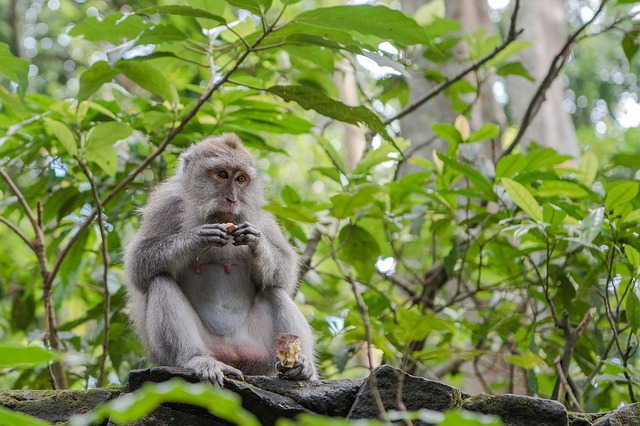
Indonesia is the third tropical forest in the world, even more threatened than the Amazon and regularly ravaged by the flames. Every minute is an area equivalent to six football pitches that is deforested according to the magazine Geo. The West Bali National Park is an example of preservation: 160 species of birds have been listed in the park, including the virtually extinct Bali Starling (Leucopsar rothschildi), the only endemic vertebrate species in Bali, the icon of wildlife. Bali. This is the main reason why this national park was created in 1941. In 2001, it was estimated that only six starlings would have survived in the wild, all in this park. Since then, captive breeding and reintroduction efforts have continued at a steady pace, but poaching pressures remain a major problem. With this in mind, a second reintroduction program was launched in the remote areas of Nusa Penida off Sanur Beach in 2004.
Tourism accounts for more than 10% of global GDP and 7% of all international trade activity. With $6.1 billion in revenue, tourism is the world’s third largest exporter, ranks after chemicals and fuels and ahead of automotive products.
Moreover, tourism is a local development aid when it leads to improvements in terms of infrastructure, such as transport (airports, roads, rail networks), land use planning for drinking water and sanitation, energy consumption, medical services, mobile phone networks and security that are appreciated by tourists and locals alike.
Inclusive growth in the tourism sector affects other sectors. Indeed, tourism depends on a large supply chain, which includes transport providers, interpreters, accommodation, agricultural producers, catering, energy, water supply, preservation of heritage. cultural, arts and crafts, construction and maintenance of buildings, preservation of biodiversity and wildlife. Thanks to this inclusive approach, tourism can benefit a large number of people.
In addition, there is a big issue for both urban and rural populations. By 2050, the urban population will increase to 66 percent, or six billion people, with concentrated growth in Asia and Africa. Many cities will continue to base their economic growth on tourism and its potential for job creation and infrastructure improvement. Rural communities attract investment to promote rural areas and also to attract the profits of tourism.
Ecotourism is growing strongly. Not only does it increase the conservation value of Nature, but it also helps to generate funds useful for its conservation. A survey conducted by UNWTO found that wildlife tourism accounts for 80% of total annual travel sales in Africa, and this share is growing. The economic impact of nature and wildlife activities motivates local people to play an active role in conserving biodiversity and preventing poaching.
Policies supporting ecotourism, or green tourism, make it possible to receive financial contributions for the preservation of biodiversity, water reservoirs and to help reduce CO2 emissions. Finally, tourism is often an innovative sector in terms of sustainable consumption and awareness of climate change. There are many examples of tourist resorts introducing wind and solar energy, organic farming and sustainable fishing.
Cultural tourism is an important segment of tourism, and visitor spending on tickets, guides and souvenirs contributes to the capital needed to protect important sites. The UNWTO “Silk Road” program, which includes 33 states, is a remarkable example.
Intangible cultural heritage, through music, performing arts and oral traditions can also be revitalized or protected by tourism. The local communities organize cultural excursions whose purpose is to share cultural diversity, an invaluable wealth for travelers who are aware of it.
Tourism can be an effective way of involving visitors in philanthropy. Social and solidarity tourism allows visitors to participate in local lives, to understand local cultures and to show empathy. For journeys also make it possible to encourage the creation of family bonds, reflections on oneself, on Life and Love.
Tourism can serve as a tool to recover from a major conflict. Rwanda is one of the most striking examples. Rwanda becomes one of the world’s destinations based on ecotourism. The priority given by the Rwandan government to sustainable development is bearing fruit. The development of sustainable tourism has not only brought new inclusive employment patterns, it supports growth and improved infrastructure in the country, and thus contributes to post-conflict stabilization.
To know more : – The World Bank study 20 Reasons Sustainable Tourism Counts for Development – UNWTO “Silk Road” program – New York Times Nyungwe forest is a magnificent place for ecotourism
The term “Murmuration” describes the phenomenon by which starlings gather spontaneously in the air to face a predator. Faced with the exponential growth of mass tourism and its negative effects on the environment, MURMURATION SAS’s approach is similar: to create an ecosystem of engaged actors from the tourist sector to quantify the environmental pressure on popular destinations and to limit its impacts in the context of climate change. It aims to create better conditions for the development of a sustainable tourism!
October 2018, the Philippines reopen Boracay, a paradise island previously soiled by mass tourism. December 2018, the famous Thai island Koh Phi Phi lacks water because of the number of tourists. April 2019, Dubrovnik tries to manage the overtourism. June 2019, deaths on the slopes of Everest increase because of overtourism …
Many stories like those ones demonstrate the effects of mass tourism. Over-frequentation? Bad tourism management? In any case, prevention is better than cure. While tourism accounts for 8% of global greenhouse gas emissions (according to the Allenvi 2019 study), it is also a socio-economic catalyst and a factor in preserving the environment through the development of new trends such as sustainable tourism.
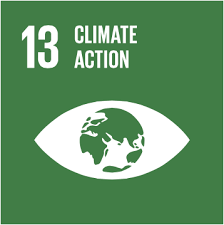
All the stakeholders have to help safeguard the places that make us dream during our travels. Tourists, tourism professionals, local authorities, associations and NGOs, governments, … All must collaborate so that the tourism activity can be a real promise of economic and social development, while preserving biodiversity and local life in a sustainable way.
Study case : Bali, a tourism booming. How to deal with environmental pressure?
This inclusive approach is possible thanks to satellite data. Combined with various data from local authorities or even the tourists (eg tourism statistics), this innovative solution aims to set up environmental pressure indicators on a global scale. Indeed, the observation of a dedicated area thanks to high-resolution satellite data allows to give reliable and transparent indicators. The satellite data are factual and invaluable because they allow to go back in time, to identify the problems but also the solutions and to foresee future evolutions.
Copyright image : rawpixel de Pixabay
Satellites offer us an incomparable view of our planet thanks to spatial data
(more…)The #SDGsTourismTalks build on the strategic recommendations of the Baseline Report on the Integration of Sustainable Consumption and Production in Tourism Policies and provide Member States with an opportunity to disseminate their efforts and commitment to develop sound tourism policies and ensure their effective implementation.


In the Sustainable Tourism Policy Talks Ministers of Tourism shared their vision on the implementation of tourism policies and the contribution of the tourism sector in order to achieve SDG 12 goals on sustainable consumption and production and other connected SDGs.
You can’t manage what you can’t measure!
5 main indicators are outlined and they are related also to the climate action SDG13 :
– Biodiversity conservation
– Energy use efficiency
– GHG emissions reduction
– Waste reduction
– Water use efficiency
To know more about the report on sustainable tourism : UNWTO efficiency resources in tourism
What is essential in your growth strategy and sustainable development? Spatial data
(more…)The attractiveness of natural and touristic areas with a rich biodiversity is a major concern in the definition of sustainable management of tourist areas. These natural areas are much more sensitive to the tourist pressure induced by the increasing number of roads, an increasing urbanization and a growing number of travelers to host, guide, restore, etc. Natural ecosystems are the first victims of overcrowding in areas that were previously difficult to access. Excessive crossing on natural paths causes significant damage to vegetation, soil and water quality. The local populations are faced with financial issues such that for most of them, they leave their craft and agricultural activities and they devote themselves totally to the tourism activity, becoming totally dependant on it.
It is the responsibility of all actors to help safeguard naturals and touristic areas : tourists, tourism professionals, local officials, associations and NGOs. Everyone must work together to put in place environmental management that is conducive to both the economic and social development of these residents. Tourism activity can be a real promise of economic and social development, while preserving biodiversity in a sustainable way. Travel, within the framework of a sustainable tourism, is an encounter with a country and the complexity of its history, its cultures, its cults, its biodiversity, its ecosystems, it’s about Life and Earth.
Our emerging collaboration with Julien Leroy, founder of Terra Nordeste, is inscribed in this context. Julien describes his activity as a “craftsman of the journey”, he furrowed for almost 15 years the most beautiful natural places of Brazil. He literally fell in love with this country. He describes those places as of a wild and catchy beauty, but they are also very fragile and threatened: “I try to propose the most authentic and the most respectful trip possible of the country. I will soon collaborate with the Toulouse company “Murmuration”. It will provide me with satellite data so that I can visualize the impact of tourism in the regions where I work. It will allow me to act accordingly. ” Interview with Julien Leroy, Founder of Terra Nordeste.
Some solutions exist, one of them is to integrate satellite data into a collaborative approach to observe a dedicated area based on reliable data and difficult to contradict. The satellite allow us to go back in time, identify problems but also solutions and predict future developments. They are valuable and factual.
Copyright credit illustration ESA
Going a few thousand miles and sipping fresh fruit juices in an exotic setting and on a hot, humid afternoon is no longer the preserve of just a few elites. The trip is democratized, it allows a greater openness to the world, to meet the other, change his habits, discover new places, admire the diverse nature around the world. The unparalleled pleasure of facing beautiful landscapes unfortunately and often has a negative impact on the environment. Several initiatives are being implemented at various scales: ecotourism, outdoors, river tourism, bicycle tourism, sustainable tourism.
We wanted to answer the following question: How to understand our impact and help reduce it?
In this case study, we will demonstrate how to quantify its impact in order to implement the necessary measures at the scale of a tourist region : Bali, an Indonesian island famous for its wooded volcanic mountains, rice paddies, beaches and coral reefs.
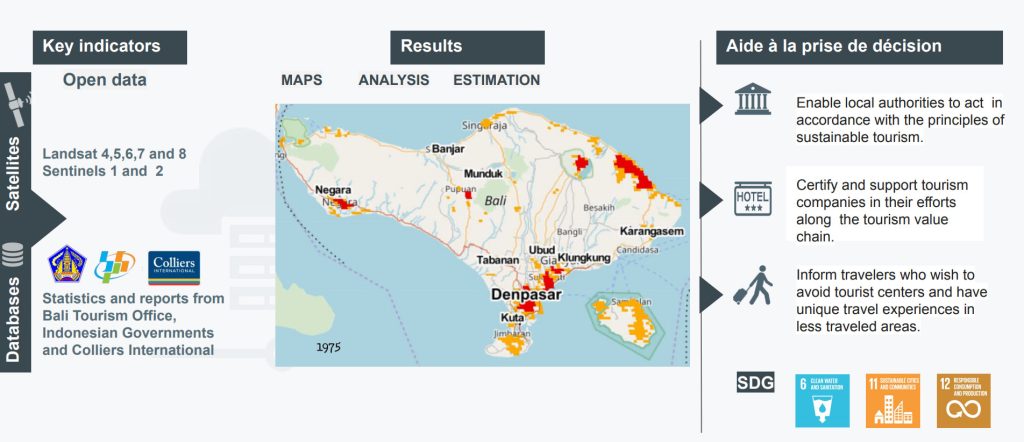
Speaking at German trade show ITB in Berlin Dr. Stroma Cole, director of Equality in Tourism highlighted that it is the sustainable management of water that will be the major vector of driving tourism in the coming years. She also mentioned that Bali will be facing a critical point at 2020 concerning the water supply and demand. This conclusion is based on the findings of several monitoring organisations, for example the Bali Hotel Association (BHA) and Howarth HTL where they report that the assumed per capita daily use of fresh water is of 183 liters, whereas for a 2 stars hotel the consumption is of 1000 liters. Knowing that lots of hotels are 2+ stars in Bali, the water consumption ratio is likely to be more than 1 to 5. For statistics concerning the number of hotels and their ratings please refer to this document.
We started to look for the available open and free data to see if this makes any sense at all.
The first dataset We looked for was statistics on the number of travellers flying to Bali to see how these fluctuated over the past decade. I found an open dataset (here) coming from the Indonesian government that showed a continuous increase in the number of tourists climbing from 2 millions to approximately 11 million visiting tourists in 2014. Moreover the data showed the number of tourists who checked-in the different attraction over the beautiful island.
The most visited region of Bali in 2014 was the south west region of Tabanan that accounts for about 40% of all tourists.

The following map shows the relative weight of each region in the constant growth of tourists.

As you can see, the region that have seen a significant increase in the number of tourists is the region situated at the south and center of the island. The sandy beaches of Kuta, the temple of Tanah Lot are major attractions in Bali. One may think that given the small size of the island, tourists have the choice of staying in the north or the center for example and visit these areas on day tours. This would mean that the increase of residential areas in these regions can be reasonable to avoid putting major stress on the infrastructures through the creation of hotels for example. Trying to identify patterns of growth of residential areas is something that earth observation data by satellites does great thanks to the global coverage and the diversity of sensors.
The European Commission’s Joint research center (JRC) has deployed significant effort to map built-up areas across the planet. The result of this effort are an open source, open tools, map layers that are available here. So I thought, perfect, let’s use this to see how the urban areas evolved over Bali over time. The results, shown in the following map, that show the evolution from 1975 to 2015, seem to be inline with the tourism influx shown in the previous map. Yeah, one of the advantages of using satellite imagery is that we can go back in time to do spatial analysis.
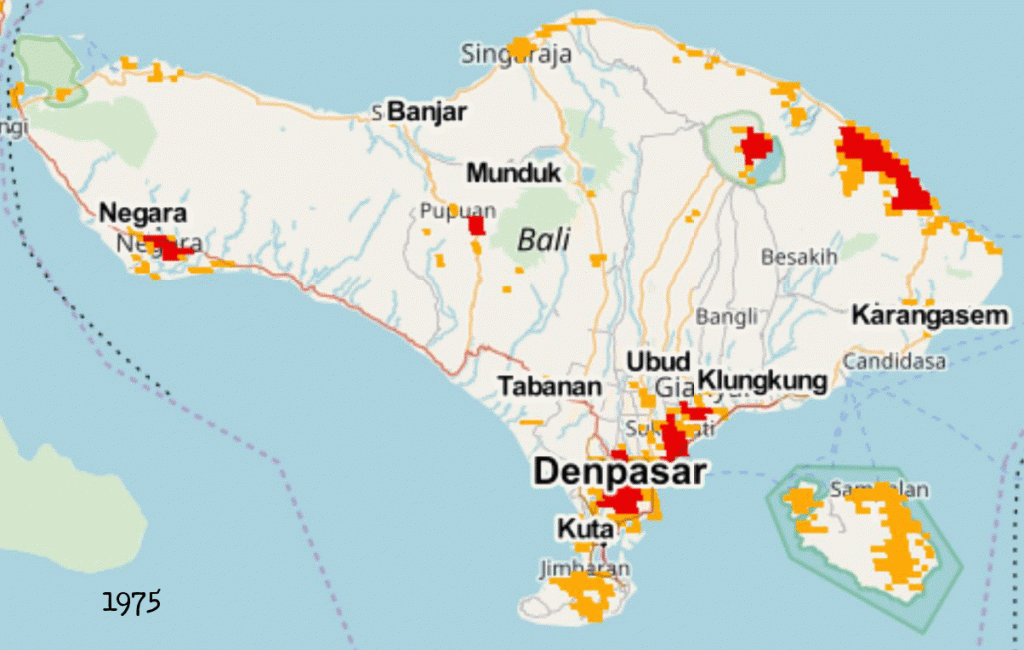
The million dollar question now is whether this increase in residential areas is only related to an increase in the number of tourists accommodation areas or whether they are related to normal increase in population. According to the official reports of the Indonesian government (here), the population in Bali has almost doubled in the period from 1971 to 2010, rising from 2.1 Million to 3.8 million persons (circa 1.1% growth rate over the last decade).
While this population growth may help explain the increase in population in the dense urban centers (the red points in the previous map), it does not explain the increase in the low density urban clusters (shown by the green areas on the map). Another indicator is the sheer increase in the number of hotels in Bali over the past decade. Indeed, according to the market analysis report issued by Colliers international (here), the number of hotels, budget and luxury hotels combined, has almost doubled over the period from 2005 to 2015. This seems to be inline with the continuous increase in the number of tourists coming to Bali.
Factually speaking, the earth observation data show that there is a construction pressure, the stats show there is a significant increase in tourist influx and that there might be correlations with the number of hotels as the number of hotels being built-up is in continuous increase. This gives food for thought, first on how available data might be used to indicate certain trends in pressure on available resources.
The objective of these reflexion is not to refrain you from going to your favourite vacation spot, but to think about the possible impact. Maybe one of the solutions would be to avoid touristy centers and stay in a non-traditional places, beside being sure to have unique experiences, you also avoid putting the pressure on resources on critical areas.

A concrete example would be for example to stay at the west or north of Bali where there is less pressure on water consumption rather than staying in the south. You will still be able to visit your favourite spots over a day trip and you will enjoy less crowd and more personalized experiences.